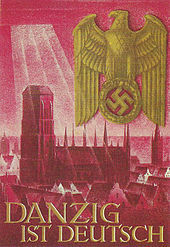Day Trip #2 with my homestay folks from Bydgoszcz took us to Gdańsk (I think it’s pronounced Geh-daown-sk) and Sopot (So… pot?), two of the three cities along the Baltic coast that make up what is known as Trójmiasto (or, three-cities). (The third city is Gdynia, but we didn’t have time for a visit.)
The trip started early in the morning, 6:30 am or so, much to the chagrin of Homestay Daughter and I. Homestay Father was ready to go, however. He woke us up, had breakfast ready so we could eat (with eyes closed) while he went and got the car. By 7 am we were in the car, and this is when I learned about Polish road trips.
You see, I didn’t know what Homestay Father actually did for work. I’m sure my friend had told me before but I’d forgotten. So, when Homestay Father plopped a GPS device, a radar detector and a two-way radio into the front seat and began assembling everything, I couldn’t help but wonder. The GPS and radar detector I understood, but the two-way radio? I ask Homestay Daughter. Apparently he works for some transportation company. The two-way radio is for contacting other drivers on highways… especially about highway cops.
Smiling, he pointed proudly to the radar detector and said “Not legal!”
I could do nothing more than nod in agreement.
And so we drove to Gdańsk, conversing with one another, listening to Polish and English pop music, and, every now and then, radioing other cars for info about cops in the area. We had no problems.
Gdańsk

Gdańsk (known, in German, as “Danzig,” like the musician) is the port city of Northern Poland. Surprisingly, our stay in the city was very short despite the historical importance of this city. In recent history the city has undergone two momentous occasions.
First, World War II started here. The first attack by the Nazis occurred at Gdańsk’s Westerplatte on Sept 1st, 1939. Apparently the Poles were able to fend off the invaders for a week before they were overtaken. The city was liberated (or almost wiped off the map) in 1945 after a good ol’ bomb-fucking by the Soviets.
The next big thing that happened here were the revolts against communism some four decades later. Those revolts culminated in the “Lenin Shipyards strike” of 1980, and is now commemorated by a huge pillar with three anchors hanging at the top. It would be almost a decade before Poland would be released from communism after the so-called “Round Table” discussions of 1989.
Whew. (Shot of Żubrowka.) History lesson over.
Nazis, Soviets, and revolts aside, our stay in Gdańsk was more of a walking tour than anything else. The main street is ulicia Długa (dwoo-ga), marked by many pretty buildings and turns into Długi Targ after the Town Hall (see picture above.) Długi Targ is made memorable by Neptune’s Fountain, which sits in front of the historic Dwór Artusa (Arthur’s Court). The Court was apparently built by some folks who were inspired by King Arthur’s Knights of Camelot and wanted their own place to assemble and scheme.
Whoops, that was more history learning. Sorry. (Another shot.)
Then we walked through the Green Gate to the waterfront, admired the view and took pictures.

We couldn’t miss, however, the staple of any walking tour in Europe: a visit to a church. (Are there any tours in Europe that don’t have a visit to a church?) Walking down ulica Mariacka we visited the monumental and old Bazylika Mariacka, or St. Mary’s Church, built sometime in the 14th century. It was a nice church, complete with images from the Bible, Latin inscriptions, and icons. The bleached-white interior didn’t look anything like the brick exterior. Unlike St. John’s Church in Toruń, which is the oldest brick building in Poland, St. Mary’s Church is the biggest brick church… in the world.

Jumping back into the car, we drove to Sopot.
Sopot

We did a quick tour of Sopot on foot. The main street is ulica Bohaterów Monte Cassino, complete with a funky looking building and a boy on a rope. The main street stops at the beach facing the Baltic Sea and is taken over by the Sopot Pier.

We walked the pier and took a look at the marina they are building at the end of the pier. Along the way we saw swans, ducks, the Baltic Sea and a camera crew. Maybe my host family and I will be in a Polish movie as unsuspecting extras.
We stopped for dinner, but I forget the name of the place. I thought it was funny that I could try something call gypsy pie. I remember making some comment about “them wretched gypsies,” which Homestay Daughter didn’t find too funny and thankfully Homestay Father didn’t understand. Noting that gypsy-jokes were off-limits, we made other conversation.
The last cultural experience of Sopot was smoked cheese, called “oscypek.” It was good and greasy.

And then we drove back to Bydgoszcz.
I’d been staying in Bydgoszcz for a week before I accepted the fact that my Polish wasn’t going to get any better. Deciding to leave Polish lessons and a singing toilet behind, I decided it was time to leave. Saying thank to my host family and trying to figure out how many kisses on each cheek I was supposed to give, I returned to Warsaw for a few weeks before finally going westward to a town called Poznań.
